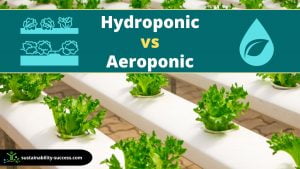Long gone are those days when farmers would spend hours under the scorching sun, planting crops with a hoe or spade and leaving the farm with aching bones. Nowadays, we don’t have those issues anymore, all due to the newly-developed farming systems: hydroponics and aeroponics. But, what’s the difference between hydroponics vs aeroponics?
Hydroponics is a type of gardening that uses no soil, instead relying on a nutrient-rich water solution to support plant growth. Aeroponics is instead a type of hydroponics that takes this one step further by growing plants in an air or mist environment. Both methods have their pros and cons, but aeroponics is generally considered to be more efficient and produce higher yields.
While both these amazing examples of green technology can improve environmental sustainability and help to grow crops effectively, they have significant differences worth noting for all farmers and homesteaders. Knowing the differences between the two can help farmers make the right decision on which system to use to produce the most yield for their crops.
Now let’s look into their main differences and start my comparison of aeroponics vs hydroponics!
Hydroponics vs Aeroponics
If you have visited any area that practices urban farming, you have most probably come across plants growing on tables, on the floor, above your head, at your chest level, or in tanks. These are all examples of hydroponics and aeroponics.
The main difference
Both hydroponics and aeroponics farming systems do not grow plants on the soil. Rather, they use special mechanisms to bring adequate nutrient solutions to the plant roots; then the nutrient solutions support the growth and yield of the plant.
Despite their similarities, hydroponics and aeroponics are very different.
Hydroponic feeds the plants by irrigating their roots with nutrient solution. In other words, hydroponics requires you to submerge the crops either full-time or intermittently in the water.
On the other hand, aeroponics works by spraying droplets of the nutrient solution directly onto the crops’ roots. Therefore, unlike hydroponics where the crops are placed in the water, aeroponics gives nutrients to the plant root via a mist. Even so, aeroponics is considered a “sub-sector” of hydroponics.
Set-Up Costs
If you do not want to incur high start-up costs for your garden, you would do well to opt for the hydroponics farming system. This is because there is a wide range of hydroponic methods that require low costs to start.
In fact, you can build a whole hydroponic farm tailored for your intended space with cheap meters, tanks, pipes, and pumps, as long as you have basic plumbing skills.
On the other hand, setting up an aeroponic farm is harder. In most cases, you will require a ready-made kit to start such a garden. And while you might still find cheaper kits in the market, you might be forced to spend a lot, say when turning a greenhouse into an aeroponic farm or starting a large-scale aeroponic farm.
Indeed, hydroponics remains to be the cheaper and more affordable option when it comes to setting up farms.
Plant Growth
Plants’ growth in both hydroponic and aeroponic farming systems is much faster than that in soil. Crops cultivated in hydroponic systems grow 30-50% faster than those grown in soil. And as for aeroponics, according to NASA, plants grown in these growing systems develop three times faster than in soil.
| Hydroponic | Aeroponic |
| 30-50% | up to 300% |
This means that, when the two growing systems are compared, aeroponics produces the fastest results.
An experiment done with sunflower seedlings in both systems showed an interesting phenomenon. At first, the seedlings grew faster in the hydroponic system, probably because crops grown in hydroponic tend to establish their roots faster.
On the contrary, the crops grown in aeroponics developed quite slowly at their early stages. This is because the plants spent a lot of energy developing their root systems.
However, once they had fully established their roots after a few weeks, the crops grew at a much faster rate (30% more) than those grown in hydroponic. This experiment proves that aeroponics leads to bigger plants and a higher growth rate than hydroponics.
Type of Plants Grown
Most plants that are grown in aeroponics also thrive well in hydroponics, and vice versa. However, when growing crops in aeroponics, avoid rooty crops, such as potatoes. Not only do such rooty plants take up too much space, but they also take up a huge amount of nutrients, making them costly to produce.
The most recommended crops to grow in aeroponics include vine plants, leafy greens and herbs.
On the other hand, the best plants to cultivate in a hydroponic system are lettuce, peppers, tomatoes, some species of flowers (such as carnations), different herbs and some berries, such as strawberries.
in addition, if you decide to grow tomatoes with those indoor systems, you will not have issues with common pests eating your produce, like birds, squirrels, deer, and other insects.
System’s Pump
Both the hydroponic and aeroponic farming systems require a pump. The pump is used to supply nutrients to the roots of the crops.
In aeroponics, the pump works by spraying droplets of the nutrient solution directly into the crop roots and with a particular set pressure. To ensure that all the plants receive the right amount of nutrients that they need, you should find accurate measurements for the PSI (pounds per square inch).
On the other hand, if you are using the hydroponic farming system, you will need to ensure the right measurements for gallons per hour (GPH). Only with the right GPH will your crops be able to obtain enough nutrient solutions and thrive well.
Therefore, hydroponic pumps are much easier to use than aeroponic pumps. After all, in hydroponics, all you need is to ensure that your plants require enough nutrient solution.
However, with aeroponics, you need to do more than just provide enough nutrients for the plants; you also need to provide these at the right pressure.
When you compare PSI and GPH, PSI is much more complicated than the latter. This is because setting up PSI requires that you consider a wide range of factors, such as the size of the pipe, the pump’s strength, and the type of nozzle you use; all these factors have a significant impact on the amount of pressure generated at the pump’s nozzles. For example, a longer pipe length would mean higher resistance by the pump.
Nutrient Absorption
According to research, nutrient absorption is higher with aeroponic growing systems than with hydroponics. The table below shows the uptake of nutrients by a lettuce plant grown in both hydroponic and aeroponic
| Hydroponic | Aeroponic | |
| Magnesium | 0.40 | 0.44 |
| Potassium | 1.81 | 2.46 |
| Nitrogen | 2.13 | 3.29 |
| Calcium | 0.32 | 0.43 |
| Phosphorus | 0.82 | 1.25 |
Since the absorption of nutrients is much higher in aeroponic systems, crops tend to grow faster than those developed in hydroponics.
In addition, high nutrient absorption in aeroponics means less wastage of nutrients, which means more money is saved in the long run.
Farming Efficiency
Compared with soil gardening, both the hydroponic and aeroponic farming systems are much more efficient than the former. However, when it comes to the usage of resources, one system is much more efficient than the other.
For example, in terms of irrigation, hydroponic systems save farmers’ water usage by 80-90% compared to soil gardening. The rate of water saving is usually dependent on the specific system used in hydroponics. On the other hand, aeroponics saves farmers up to 95%, making it more effective than the former.
In terms of saving on fertilizer, aeroponics saves you 85%. However, hydroponics fluctuates between 55% and 85%, depending on the specific hydroponic system used. And when it comes to productivity, hydroponics generates 100-250% more yield than soil gardening, while aeroponics produces 300% more!
This means that both hydroponics and aeroponics are more sustainable agriculture methods compared to traditional soil gardening.
Yield Comparison of hydroponics vs aeroponics
When it comes to yield comparison, aeroponics takes the first place in most cases, since it leads to the production of bigger plants. However, note that bigger plants do not always mean bigger yield or more extensive produce. This is especially so when it comes to crops such as cucumbers, tomatoes, and peppers.
Therefore, we can say that the yield for both hydroponics and aeroponics varies in different cases. For example, aeroponic usually produces more yield than Deep Water Culture and other similar hydroponic techniques, such as the Kratky method. Also, spinach, cress, lettuce, and other short-living plants produce higher yields when grown in aeroponic systems, with most of these being ready for harvest in six weeks’ time.
As for other vegetables, more research is yet to be done on which growing system produces a higher yield. However, generally, aeroponics can be crowned as the winner when it comes to yield production, as per the research already conducted.
Conclusion
So the big question is: hydroponics vs aeroponics, which one is better?
Both farming systems are very sustainable since they help to preserve water and prevent wastage, contributing to environmental and economic sustainability. And while aeroponics is associated with low running costs, production of healthier plants, and bigger yields, hydroponics has very low start-up costs and can be used both indoors and outdoors.
So which of the two systems should you settle for?
Well, if you intend to familiarize with the advancing of tech and specialize in high-tech gardening methods and have a good budget set aside for starting the farm and maintaining it, you would do well to go for the aeroponics system. On the other hand, if you have a tight budget or are thinking of planting a variety of crops on the farm, the hydroponics system would be more suitable for you.
Still, regardless of the farming system you decide to use, rest assured that it will contribute to a greener and more sustainable world; one that will be ideal for us and even beneficial for many more generations to come!

